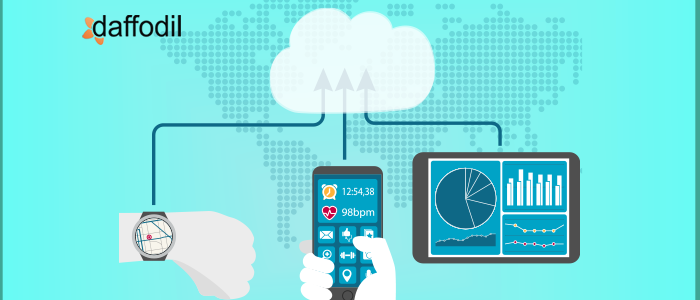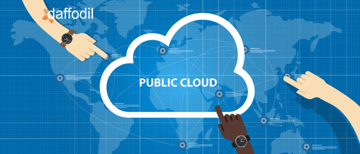
On-time, accessible, and cost-effective care delivery has been an overextended issue in the healthcare industry. The situation became extremely daunting amid the COVID-19 pandemic.
To deal with the shortcomings of the healthcare sector, almost every nation took the digital route to stabilize care services. For example, virtual consultations through telehealth solutions became the new normal, in-home chronic condition monitoring saw a rise, EHR-telehealth integrations ensured interoperability, and patient data management was handled efficiently.
To make this possible, modern technologies had a major role to play. Artificial Intelligence (AI), Internet of Things, Blockchain; all these technologies were at the forefront to fight against the consequences of the pandemic. For example, Artificial Intelligence aided in detecting severe COVID-19 cases, accelerating the research cycle, predicting the impact of quarantine, and more.
READ MORE: How Artificial Intelligence is Helping Fight the COVID-19 Pandemic
Similarly, the Internet of Things (IoT) is enabling healthcare platform development companies to improve care efficiency and reduce the cost associated with it. As AI technology is evolving and connected devices are penetrating the market, IoT is becoming an integral part of various healthcare devices. These IoT devices have found their applications in hospitals, with insurance companies, physicians, and patients. Let’s find out, how.
Patients: Wearable Health Devices (WHD) are helping patients in self-monitoring of health vitals. For example, blood pressure, heart rate, blood oxygen saturation, blood glucose, skin perspiration, respiration rate, body temperature, calorie count, etc. are some of the vitals that can be tracked at home using these IoT-enabled WHD.
IoT has been a great help in chronic disease management of the geriatric population. These devices have proven effects on those living alone. Any disturbance in the vitals sends an alert to the patient or their family members, helping them to take necessary action on time.
Physicians: As patients are more informed about their health vitals these days, it is enabling clinicians/physicians to provide better, on-time care. If the physician receives an update on the patient’s vitals, they would be able to track the patient’s adherence to treatment plans, can diagnose a problem at an early stage and provide treatment for it, track a patient’s recovery rate, and much more.
Hospitals: IoT devices have numerous use cases in a hospital. For example, real-time trackers help in locating medical equipment in the inventory such as oxygen pumps, nebulizes, injections, etc. These IoT devices also help in pharmacy monitoring, environmental monitoring, checking refrigerator temperature, humidity, etc.
Insurance Companies: Insurers leverage IoT health devices for various reasons including underwriting and claim operations. The data received from wearable health devices allow insurance companies to detect fraud claims and identify the prospects of underwriting.
IoT in Healthcare: Some Use Cases (With Examples)
IT departments of healthcare organizations are making the most out of the IoT technology, followed by research & development. Three of the major areas that are positively impacted by IoT includes:
- Remote Patient Monitoring
- Wellness & Prevention
- Operations
Here are a few examples showing how IoT-enabled smart devices are facilitating medical treatment, enabling wellness and prevention, and aiding the healthcare system.
1. IoT Enabled Virtual Hospitals/Wards
Wearable Health Devices are enabling care providers to create hospitals without walls. These hospitals facilitate outpatient, long-term care where physicians and nurses continuously monitor the vital signs of a patient, remotely. This frees up the bed space for patients who needs intensive care.
In response to COVID-19 treatment, the Houston Methodist Hospital accelerated its plan to build virtual intensive care units. This 2-year project was shortened to a 6-month project, which ensured that there is an increase in bed availability, offered effective ICU care, thereby limiting patient’s & physician’s exposure to the virus.
Similarly, virtual wards are trialed and operated in Sydney, Australia. The concept became normal to cope with the COVID-19 pandemic in Australia. One of the healthcare centers in New South Wales redesigned its hospital to provide remote care to patients showing COVID symptoms. A pulse oximeter was attached to the finger to measure heart rate and oxygen saturation rate, along with armpit patches to measure the body temperature. The data is then transmitted through an app on patients’ phones to the staff at the virtual hospital.
Not just the COVID situation, virtual hospitals can be a great help in remote care monitoring in the longer term. Virtual hospitals can be transformative for patients with chronic illness. Such a concept will improve care and monitoring for housebound patients and for those who are unable to access care because of the location.
2. IoT for Early Detection of Disease
Virtual hospitals need supportive technology to ensure disease prevention and detection. For that, hospitals staffs were equipped with wearable biosensors. These small-sized devices are worn on the body to monitor crucial health vitals such as heart rate, body temperature, respiration rate, etc. This helps the physicians/clinicians to keep a track of critical insights into the progression or early onset of illness.
Philips designed a wearable biosensor BX100 that helps hospitals to detect early health deterioration in COVID-19 patients. It’s a 5-day, single-use wearable patch that can be used to monitor multiple patients in multiple rooms. It can be incorporated into the existing clinical workflow to view details and notifications. The BX100collects, stores, measures, and transmits respiratory rate and heart rate every minute, adhering to the patient’s chest.
Such innovation is helpful to continuously monitor patients in the COVID ward as doctors cannot move in or out of the ward without protective gear. This helps them to remotely track the health of every patient and give treatment, accordingly.
Wearable smart devices help in data collection from patients. It ensures that collecting health vitals is possible, even if the patient is out of the outpatient care unit.
3. IoT for Adherence to Treatment Plan
The best medication for chronic ailments is adherence to the treatment plan. For respiratory problems such as asthma or COPD (chronic obstructive pulmonary disease), sufficient monitoring and treatment adherence is the key to better management of the condition. Studies suggest that 2 out of 3 deaths due to Asthma are because of non-adherence o medicine plans.
IoT-enabled smart or connected inhalers help patients to adhere to the medication regimes, collect breathing vitals that aid the physicians to track the health & treatment, and even predict attacks before they occur. Smart inhalers are designed to connect with a mobile application. Both the IoT device and the application work together to help patients and physicians with medication schedules.
Patients suffering from chronic ailments require to adhere to the treatment schedule in order to keep the symptoms under control. Smart inhalers, which is one of the inhalation therapy helps to mitigate or reduce the risk of exercabation.
4. IoT for Geriatric Care
Elderly people are usually at high risk for health problems. Medicine adherence, continuous checking of health vitals, on-time consultation, and follow-up sessions are some of the things that need to take care of for elderly people to have better health. With the Internet of Things, providing care to the geriatric population has been easier than ever.
Setting reminders about medication, sending notifications about a fall, or change in behavior/vitals to the carers (who remotely observe their people) are some of the benefits that IoT offers for geriatric care.
Apart from this, smart devices can be a great help in measuring significant vitals such as blood pressure, blood glucose, oxygen level, body temperature, hydration level, etc. IoT-enabled devices capture the risk of exacerbation and avoid admission to hospitals.
How to Get Started with IoT in Healthcare
IoT spending by healthcare providers is going to grow with respect to the benefits it offers. If we analyze some of the best use cases of IoT in healthcare, then we can see that an IoT in itself is not a complete solution unless it connects with an app to transmit the data that it collects and stores.
At Daffodil, we help healthcare providers to integrate the best of applications with their IoT devices. To know more about our IoT healthcare expertise, visit our page that briefs about our healthcare development services.



